Old city-Icherisheher
Monuments of universal value
Maiden Tower
The Maiden Tower of Baku was built in the cylindrical form on the giant rock inclined towards the coast of the Caspian Sea. An oblong support (buttress) is attached to it from the seaside. The height of the tower on the northern part is 31 m, on the south- 28 m. The diameter of the tower on the first floor is 16.5 m. The thickness (width) of the wall on the first floor is up to 5 m. The interior part of the tower is divided into 8 floors. Each floor is covered with the arched ceiling made of cut stone. There are round holes in the middle of the stone ceilings. The holes are vertical. Thus when you look through the round holes in the middle of the 8 storey ceiling you can see the floor of the first storey. The single entrance to the tower is the arched doorway in its western part 2 m in height and 1.10 m in width. The height of the first floor of the tower is 3 m, the average height of the other floors is 2.5 m.
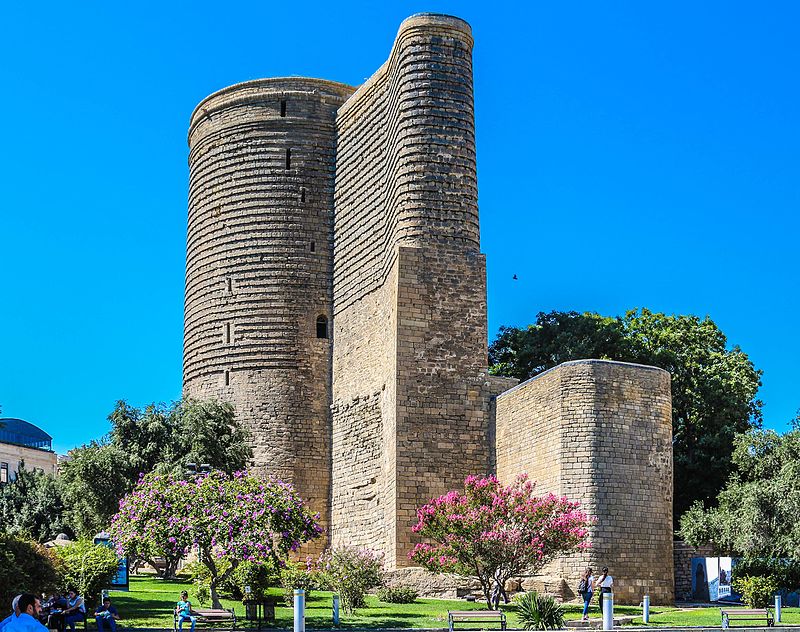 The inter-floor communication is maintained by means of stairs built within the southern –east wall of the tower. It is interesting that the communication between the first and the second floors can only be maintained through the round hole in the ceiling by means of a ladder or a rope. It should be noted that in past the door of the Tower was also multistage.
The inter-floor communication is maintained by means of stairs built within the southern –east wall of the tower. It is interesting that the communication between the first and the second floors can only be maintained through the round hole in the ceiling by means of a ladder or a rope. It should be noted that in past the door of the Tower was also multistage.
It is proved by the ruins of the structures remaining on the arched ceiling of the doorway which in length is equal to the width of the Tower wall (5 m). There were also several wells in front of the door in past. Thus, in the Middle Ages everybody who wished to enter the Maiden Tower had to carefully pass the wells, climb up the ladder to the door, pass through doors at the entrance and finally reach the first floor. A rope or a ladder was used to reach the higher floors through the central hole.
In order to keep under control the southern and southeastern sides, especially the sea, loopholes were made. They also served to ensure inward draft to the Tower. In 1962-63 archaeological excavations were carried out on the floor of the first stage of the Tower. The excavation conducted at the depth of 5 m revealed that the foundation of the Tower was built on the giant rock inclined towards the coast. Therefore a conclusion may be made that the buttress attached to the monument from the seaside acted as the principal support against the inclination.
During research works carried out in the Tower in 1964 it was found that there were big wooden beams 14 m in height stretched inward from the foundation. Their function is not known. Probably, these beams are related to a hidden construction inside the buttress or acted as amortization against the earthquake. This suggestion can only be clarified by means of electromagnetic waves given from both sides.
The thorough calculations have revealed that the thickness of the Tower wall at the base is 5 m while at the higher part it is 4.5 m. This shows that the base and the upper parts of the tower were built at the same time that disproves suggestions of some author regarding their construction in different periods. Because the wall 5 meters in thickness provided a strong foundation for the whole 12-meter Tower, not only for its lower part. The secret of the preservation of the Maiden Tower is explained just with the fact that it is built on such a strong foundation.
One of the specific features of the construction design of the Baku Maiden Tower is a water well cut in the rock within the Tower. The well with a diameter of 0.7 m is within the southeastern wall of the Tower. Excavation works were conducted in the well. The artifacts found in the well show that it has been used since XII AD. According to estimations, the well has no linkage with the sea water level. Chemical analysis of the well water showed that is good to drink. The well’s mouth starts at the third floor level of the Tower descending along the wall at the depth of 13 m. To ensure safety the well is hidden within the Tower wall. Steps 10-12 m in depth are made in its northern and southern walls to move up and down. At the depth of 12 m, the wall becomes wider.
It is supposed that the secret underground passage between the Maiden Tower and the Shrivanshahs’ Palace started just from the lower part of the well. The first underground passage revealed during the wide-ranging archaeological excavations carried out in the eastern part of the Icherisheher in 1982 is situated meridionally to the east of the street which goes beginning from the Shamakhi Fortress Gate towards the Salyan Gate and is considered to be the main commercial street of Baku.
It is worthy to note that the road line passes under the Multani caravanserai built in XIV AD and goes to the Maiden Tower. One of the reliable evidence for determination of the age of the Maiden Tower is a 0.4x0.6 m stone slab with an inscription placed at the height of 14 m above the Tower entrance on its outer side. The inscription says: “The Dome –Masud ibn Davud”. Some scholars suppose that Masud ibn Davud is the name of the architect who built the Tower. They rest this supposition on the inscription on a circular tower of the Mardakan fortress. The inscription on the Mardakan Tower says: “Architect Abd-Al-Majid ibn Masud”. The researchers believe the architect Abd-Al Majid was the son of the architect Masud who built the Maiden Tower. Also, it has been discovered that the inscription on the stone in the Maiden Tower was placed on the wall in a very careless way. It was negligently attached to the section of the wall bound with stone framing. According to other researchers, the inscription was attached there when the Tower was built. As for the identity of Davud’s son Masud, the medieval sources evidence that he was a grandson of the Seljuk Sultan Mahmud. Sultan Mahmud was a ruler of Azerbaijan at the beginning of XII AD. Perhaps in this period, his grandson Masud reigned over Northern Azerbaijan and this inscription was attached to the Tower wall at his desire to perpetuate his name.
The researchers, who on the basis of its structure, attribute the history of the monument to the ancient periods, state that it dates back to the Zoroastrian period – supposing it to be a Zoroaster cell, a fire-worshipper’s temple or a building relating to goddesses Mithra and Anahita. To their opinion, the Maiden Tower which was the fire-worshippers’ temple, can be built on the Caspian coast, among natural fires just in the ancient fire town “Fire Baquan” in VIII- VII BCE under the influence of the towered temples of Caspiana and Midiya.
Based on the resemblance of the Maiden Tower to the Chirag Gala defence Tower (donjon) many of scientists believe it is possible to say that it was part of the Gilgilchay defence system. Given resemblance of architectural elements of the Maiden Tower to the North-Eastern Albania donjons, it can be attributed to V-VI AD. As is known from the history, Baku, which is considered to be one of the southern towns of the Caucasian Albania, was under influence of the Sasanian Iran. It is possible to suppose that the Maiden Tower was part of a defence system built in the southern periphery (occupied province) of the Sasanian Empire just in the territory of Albania.
The Maiden Tower which was damaged in various battles for ages was gradually rehabilitated and in the middle ages served the defence of the city together with the Baku Fortress wall. The changes to the construction of the monument also prove this. The Tower is of such shape that in case of a conquest of the city by an enemy, the ruler of the country and his entourage can close the doors and stand a long-term siege. As all these features are specific to all defensive Towers, therefore it could not be necessary to take such defensive measures for any temple, watchtower or observatory. Of course, it is not refuted that the tower was used purposively for its period. A resemblance of the Maiden Tower to the magnificent defensive Towers (Mardakan, Ramana, Shuvelan, Nardaran Towers) of Absheron can be noted.
A cavity in the form of a well accurately built with stone from the second floor to the seventh floor is within the south-western wall of the Tower. On each floor, there is a semicircular niche at the place of the cavity. Within the cavity are pottery pipes 40-45 sm in length with the diameter of 25-30 sm and 2,2 cm thick walls which are set on each other downward. The joints of the pipes (surface and outer part of the wall) were mortared. Beginning from the first floor to the base of the Tower the pipes are replaced with quadrangular pottery gutters of 22x18 sm. The gutters go through the wall outward. Traces of a pottery wheel are clearly seen on the surface of the pottery pipes and gutters.
Archaeological excavations in the Icherisheher are going on.
Shirvanshahs’ Palace Complex
One of the masterpieces of the medieval architecture of the ancient city is the residence of Shirvan governors – the Shirvanshahs’ Palace Ensemble which has preserved its historic and architectural features up to date.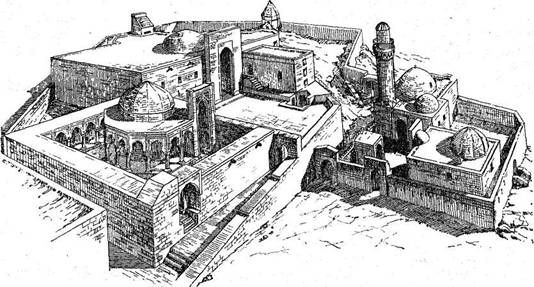
In the Middle Ages when Shamakhi was in the period of disturbances, Baku developed in a relatively quiet situation. It was known that the strong fortress walls had been built in Baku in XII century (1138 -1139). After the earthquake that shocked Shamakhi, the capital was transferred to Baku and the Shirvanshahs’ Palace was erected.
The Palace ensemble consists of 9 buildings: the Palace, the Divankhana (Court –House), the Dervish’s Mausoleum, the Eastern Gate (Portal), the Palace mosque, the Key-Gubad mosque, the Palace Burial-Vault, the Hamam (bath-house) and the ovdan (ancient underground water supply construction).
The complex consists of 3 courtyards with buildings towering above each other by 5.6 m. As the Palace is located in the area with rugged terrain it has no a single architectural plan. However, the buildings do not contrast with each other. Moreover, they group well. Looking from the different points one can clearly see that they are integrated part of the Palace ensemble.
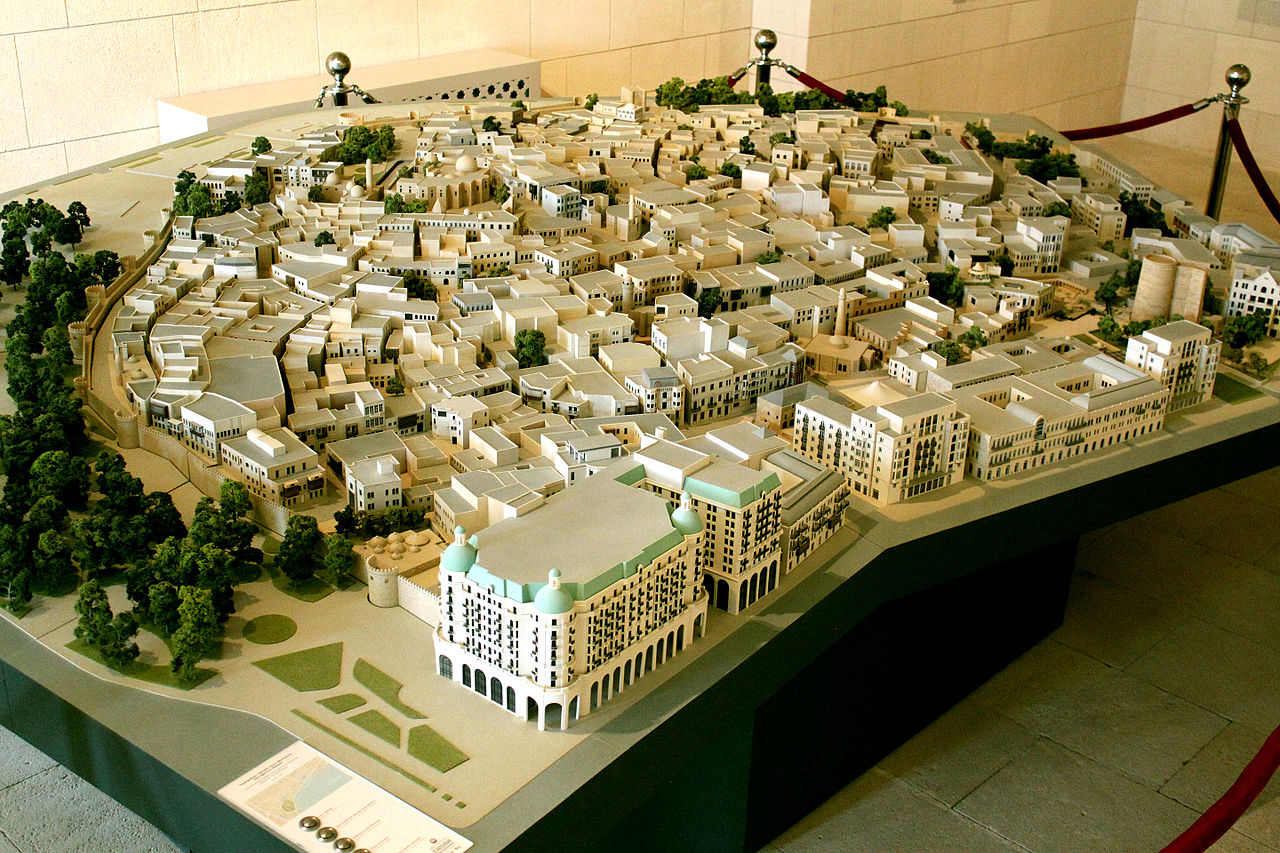 All the buildings of the complex were built with local limestone (“badamdam”). The most ruined structure of the complex is the Palace building.
All the buildings of the complex were built with local limestone (“badamdam”). The most ruined structure of the complex is the Palace building.
After killing of Farrukh Yassar in a battle between the Shirvanshahs and the Sefevi in 1500 the Palace was plundered. It is not known who lived in the Palace after the Shirvanshahs.
Continued wars between Iran and Turkey for the rule over the Southern Caucasus were run also in the territory of Azerbaijan. Located at the crossing of the caravan routes Shirvan was attacked frequently and as a result, the Palace changed hands. This is proved with the Murad Gate built during the Turkish reign. There are the monuments in the Baku fortress dated from the Persian sway. During shelling Baku by troops of Peter I in 1723 north-east facade of the Palace mosque was damaged.
After the seizure of Azerbaijan by Russia on 10 February 1828 and transfer of the Palace structures to the headquarters staff the renovation was done here and the Palace has been 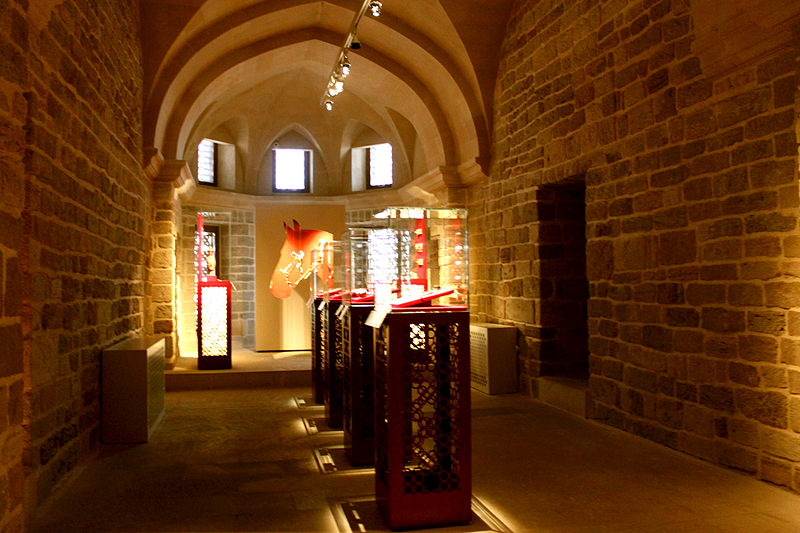 converted into the headquarters. A lot of valuable buildings were demolished. Moreover, the Alexander Nevsky Church was planned to be constructed there. The Palace was destroyed and neglected at the end of XIX century. On October 5, 1918 Decree by the Azerbaijan Democratic Republic “On Inventory and Preservation of Art and Ancient Monuments Belonging to the Public, Institutions, and Individuals” was published. It was a step taken by the government to make the first inventory of ancient monuments. In 1932, the renovation works started in the Shirvanshah complex under Decree of the Azerbaijan Soviet of the People’s Commissars. In 1937-1938, archeological excavations were conducted in the Palace under the guidance of the archeologist V. N. Leviatov and a lot of artefacts were found. For some periods a part of the Azerbaijan Folk Musem and the Museum of Religion were located in the Palace building. Since 1954 the Shirvansahs’ Palace Complex has been converted into the State Historical-Architectural Reserve Museum. In 1960 a decision was made on the protection of the Palace as an architectural monument.
converted into the headquarters. A lot of valuable buildings were demolished. Moreover, the Alexander Nevsky Church was planned to be constructed there. The Palace was destroyed and neglected at the end of XIX century. On October 5, 1918 Decree by the Azerbaijan Democratic Republic “On Inventory and Preservation of Art and Ancient Monuments Belonging to the Public, Institutions, and Individuals” was published. It was a step taken by the government to make the first inventory of ancient monuments. In 1932, the renovation works started in the Shirvanshah complex under Decree of the Azerbaijan Soviet of the People’s Commissars. In 1937-1938, archeological excavations were conducted in the Palace under the guidance of the archeologist V. N. Leviatov and a lot of artefacts were found. For some periods a part of the Azerbaijan Folk Musem and the Museum of Religion were located in the Palace building. Since 1954 the Shirvansahs’ Palace Complex has been converted into the State Historical-Architectural Reserve Museum. In 1960 a decision was made on the protection of the Palace as an architectural monument.
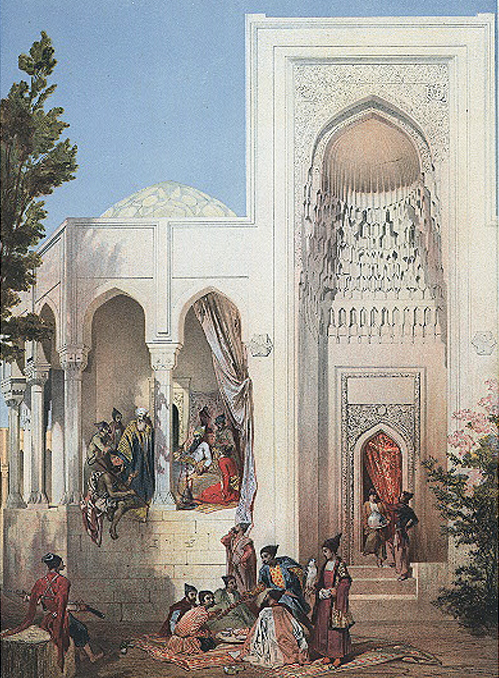 The Palace building. The Palace is a two-storey building in the form of an irregular rectangle. For proper lightening of the Palace, its southern-east corner was slotted. Initially, there were 52 rooms in the Palace, 27 of them were on the 1st floor, 25 – on the 2nd floor. The rooms were symmetric. On the 2nd floor, the arched rooms for Shah and his family were located. The windows of the 2nd floor have a nice outlook over the sea. They are decorated with stone tracery (bar-pattern –shebeke).
The Palace building. The Palace is a two-storey building in the form of an irregular rectangle. For proper lightening of the Palace, its southern-east corner was slotted. Initially, there were 52 rooms in the Palace, 27 of them were on the 1st floor, 25 – on the 2nd floor. The rooms were symmetric. On the 2nd floor, the arched rooms for Shah and his family were located. The windows of the 2nd floor have a nice outlook over the sea. They are decorated with stone tracery (bar-pattern –shebeke).
As the residential building had no a dome, in 1932-1934 when the first renovation started in the Palace it was covered with a flat roof and parquet was laid on its floor. Masonry was demolished on the windows built in the XIX century and a part of the stone floor was repaired. Inter-floor communications were kept through 2 narrow staircases and the stairs located in the floor of the octagonal hall. As a result of the renovation, now there are 16 rooms in total on the second floor. The octagonal hall at the entrance is distinct among these rooms for its initial shape. The initial shape of the second octagonal room next to it has been preserved partly. Its arched roof was replaced with the flat roof. The rest 14 rooms have also been rehabilitated; however, they are not so interesting in terms of architecture. The magnificent main entrance is in the western wall of the building. The magnificent portal which represents all elements of Azerbaijan architecture of the XV century and has no any decorative element captures attention. There is a deep niche on the right and the left sides of the entrance.
Divankhana. The Divankhana complex is situated in the upper courtyard and its northern corner adjoins the residential building. The Divankhana consisted of 8 octagonal rotundas 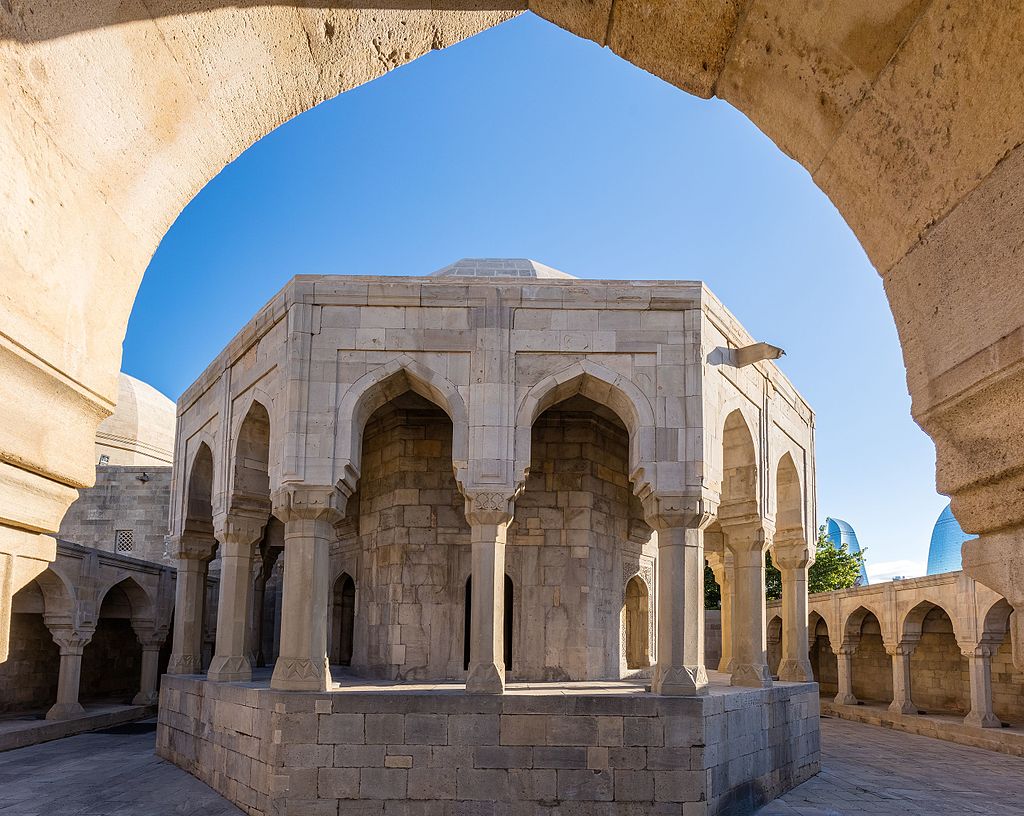 covered with the twelve-sided dome. It is connected with the octagonal hall through the open porch. The pointed arcade of the porch rest on the 9 columns which have specific capitals and pedestal. The arcade of the porch surrounding the courtyard is of the same form. On the outer side of the arches are a stone with the image of a dove symbolising freedom and 2 stone gutters. The building was used as an assembly room and court-room. Also, the possibility may not be denied that Shirvanshah Farrukh Yasar built the Divankhana complex as a mausoleum for himself. However, the construction had not been finished. The traces on the columns show that formerly they were decorated with fine stone bas-relief. The pillared place was intended for meetings of the distinguished feudals. The Divankhana has 2 entrances from the upper courtyard and the street. The rotunda also has 2 entrances. The western entrance is distinct for its tall and delicately worked portal. The surface of the portal was decorated with the fig and vine leaves specific to the characteristic Absheron flora, the ornament resembling the oriental carpet decoration and carving 3-5 sm depth. The portal, the ribbed semidome rest on the 7-row stalactic belt. There are two hexagonal medallions in the portal frame, leftward within them, six diamonds making up the geometric pattern in form of rosette are seen. Two diamonds have inscriptions: “There is no god but Allah”, another one: ‘Muhammad is a messenger of Allah”, the last one: “Ali is close to Allah”.
covered with the twelve-sided dome. It is connected with the octagonal hall through the open porch. The pointed arcade of the porch rest on the 9 columns which have specific capitals and pedestal. The arcade of the porch surrounding the courtyard is of the same form. On the outer side of the arches are a stone with the image of a dove symbolising freedom and 2 stone gutters. The building was used as an assembly room and court-room. Also, the possibility may not be denied that Shirvanshah Farrukh Yasar built the Divankhana complex as a mausoleum for himself. However, the construction had not been finished. The traces on the columns show that formerly they were decorated with fine stone bas-relief. The pillared place was intended for meetings of the distinguished feudals. The Divankhana has 2 entrances from the upper courtyard and the street. The rotunda also has 2 entrances. The western entrance is distinct for its tall and delicately worked portal. The surface of the portal was decorated with the fig and vine leaves specific to the characteristic Absheron flora, the ornament resembling the oriental carpet decoration and carving 3-5 sm depth. The portal, the ribbed semidome rest on the 7-row stalactic belt. There are two hexagonal medallions in the portal frame, leftward within them, six diamonds making up the geometric pattern in form of rosette are seen. Two diamonds have inscriptions: “There is no god but Allah”, another one: ‘Muhammad is a messenger of Allah”, the last one: “Ali is close to Allah”.
The left hexagon has 12 diamonds: 6 of them has the inscription “There is only one Allah”, the other 6: “Mohammad”. The internal passage to the rotunda next to the portal is also marked with nice ornaments. Above the ornaments, 10 suras from Quran (Yunus Sura 25, 26, 27 ayahs) were inscribed
Artistic effects are expressed here with the lights and darks depending on the specifics of the masonry. One of the courses is horizontal, the other one is vertical that ensures various shading of the stones. The similar construction of the walls is traceable in all buildings of the ensemble.
There are hexagonal medallions on the rib of the rotunda arch, with name “Ali” inscribed on their stones in 3 convex and 3 concave forms. There are no ornaments on the doorways and the entrance is incomplete while there is frame prepared for inscription. It is supposed that the construction of the building was suspended in the period of wars in 1500-1501. The central hall if the rotunda has no ornamental finishing, its sides still remain at the place of the doorway beams and pointed grooves. Quadrangle staircase in the middle of the central hall provides a connection with the basement. Different opinions are expressed regarding their purpose. It is also supposed that it may be a sepulchre.
A rectangle corridor is on the lower part in front of the central hall. The corridor is ended with the magnificent portal on the one side, and the two entrances from the small southern door –on the other side. A small service room is in the eastern part of the corridor: 5 wells of different depth (3-15 meters) are in the Divanakhana courtyard. Probably they were used for food storage.
The perfection of the architectural style of the Divankhana, high grade of ornamentation shows that the Azerbaijani nation has great architectural heritage. Central place among the portal compositions existing in the Shirvan belongs to the Divankahana and the Shirvanshahs’ sepulchre portal. For its beauty and fineness, the Divankhana is considered to be a masterpiece of the similar architectural monuments either in Azerbaijan or in the Middle East.
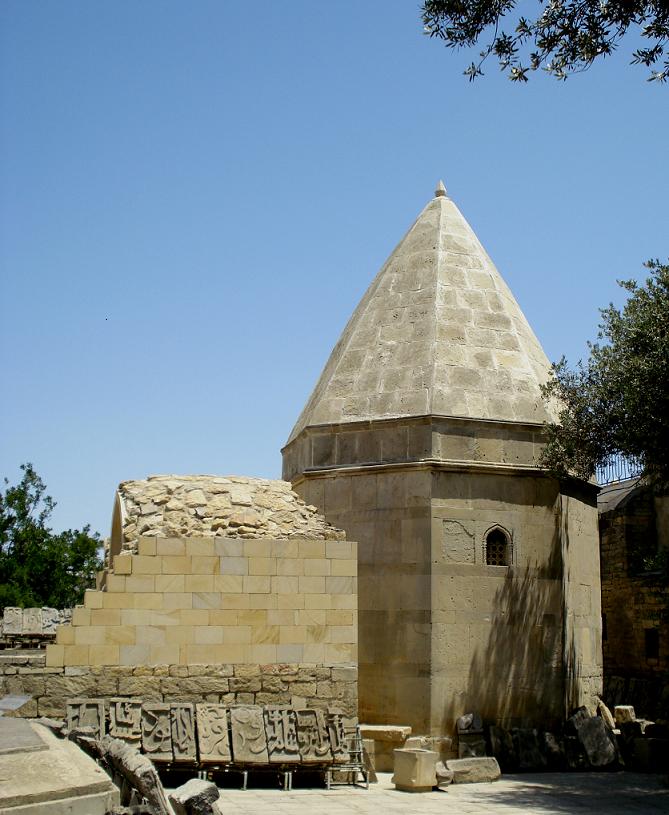 Dervish Tomb. The tomb named by the people “Dervish Tomb” and located in the southern part of the courtyard takes the central place in the middle yard. Some experts allege that it belongs to Seyid Yahya Bakuvi. Some experts groundlessly attribute all the monuments existing in the lower courtyard, including the Dervish Tomb, to the Khanagah buildings complex.
Dervish Tomb. The tomb named by the people “Dervish Tomb” and located in the southern part of the courtyard takes the central place in the middle yard. Some experts allege that it belongs to Seyid Yahya Bakuvi. Some experts groundlessly attribute all the monuments existing in the lower courtyard, including the Dervish Tomb, to the Khanagah buildings complex.
According to historians, Seyid Yahya Bakuvi was one of the court scientists in the Khalilullah I Period. He was born in Shamakhi. In his youth, he was a follower of the Sheykh Sadraddin sect. Upon the death of Sheykh Sadraddin he came to Baku and lived here to the end of his life. According to some authors, he died in 862 Anno Hegirae. Seyid Yahya Bakuvi’s 30 works have survived to our days. They are of Sufism- mystic nature and are kept in the Muradiyya Library in the town of Manisa, Turkey.
The Tomb is within the complex where the Keygubad Mosque foundation is located. It should be noted that there was neither an inscription indicating to whom it belonged nor a headstone within the tomb. The tomb is notable for its fine structure. The small octagonal tomb has been worked with high workmanship. To enrich its exterior the pyramidal surfaces of the dome are slightly convex. The height of the tomb is 7.5 m. The tomb consists of the underground and ground parts. The masonry of the walls was done with dark and light stones and due to their rotation, the surfaces look like the coloured. The tomb has three windows decorated with stone tracery.
Epigraphy researcher Meshedikhanim Nemat supposes that the dervish buried within the Shirvanshahs’ Palace Complex at the place which up today is named by the people as the Dervish Tomb (Mausoleum) as the person who had written the inscription of the “Diri Baba” near Maraza in 805 Anno Hegira (1402-1403) during Shirvanshah Sheykh Ibrahim period (1382-1417). Such octagonal tombs are widespread in the Azerbaijan architecture (Shamakhi, Agdam, Agsu, Khachmaz, Guba). However, the Dervish Tomb (Mausoleum) is the finest specimen among these tombs.
The Keygubad Mosque. The Keygubad Mosque was a mosque-medrese building adjoining the Dervish Tomb. The Tomb is located to the east of the mosque. The Mosque comprises 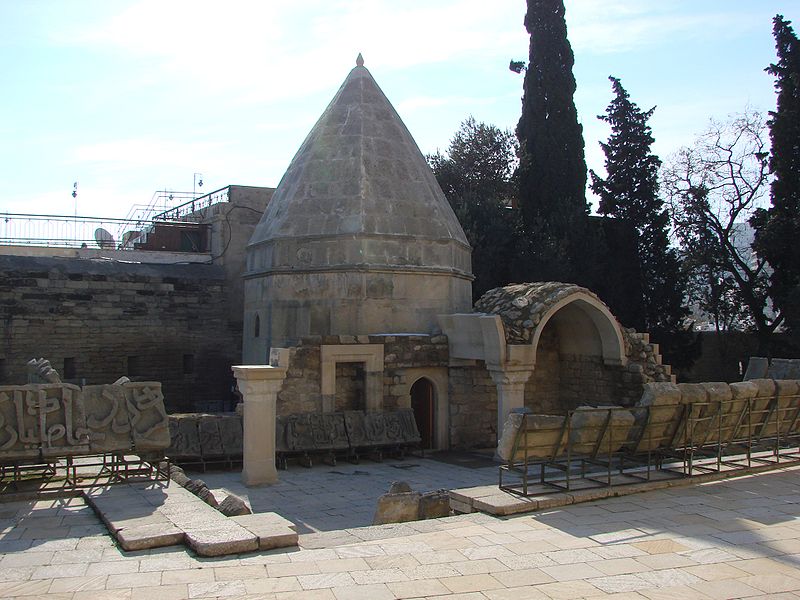 a praying hall and a small corridor before it. Formerly there were four columns in the centre of the hall to support the dome. A. Bakikhanov wrote about teaching and praying by Bakuvi: “The cell where he prayed, the school where he taught and his tomb are there – in the mosque”. According to researcher S. Ashurbeyli, Keygubad was the grandfather of Sheykh Ibrahim. Shirvanshah Keygubad was in power from 1317-1343. Only the remains of the foundation and several safe arches for the Keygubad Mosque survive now.
a praying hall and a small corridor before it. Formerly there were four columns in the centre of the hall to support the dome. A. Bakikhanov wrote about teaching and praying by Bakuvi: “The cell where he prayed, the school where he taught and his tomb are there – in the mosque”. According to researcher S. Ashurbeyli, Keygubad was the grandfather of Sheykh Ibrahim. Shirvanshah Keygubad was in power from 1317-1343. Only the remains of the foundation and several safe arches for the Keygubad Mosque survive now.
The Eastern Gate Portal. The only structure dated back to the XVI AD is the Murad Gate. the Murad Gate Portal’s 2 medallions on the upper frame contain the following inscriptions: “This building was built in the period of the Great and Fair Sultan III Murad to order by the Grand Rejeb Bakuvi in 994 (1585-1586)”.
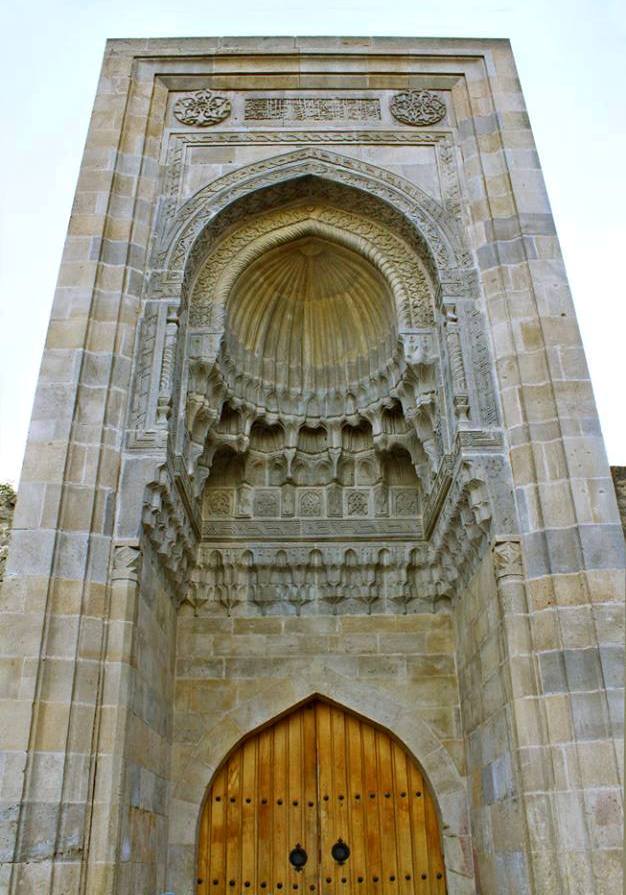 The inscription on wall niches of the Portal contains the name of architect Amirshah from Tebriz. With its general, artistic and decorative composition the portal is congruous with the Divankhana and the Mausoleum. However here the quality of construction techniques and the stones is much lower. Style purity of the Azerbaijan ornamental art is violated here. While the architect tried to maintain the stability and harmony of the ensemble he failed to avoid worsening of high architectural quality specific to that period.
The inscription on wall niches of the Portal contains the name of architect Amirshah from Tebriz. With its general, artistic and decorative composition the portal is congruous with the Divankhana and the Mausoleum. However here the quality of construction techniques and the stones is much lower. Style purity of the Azerbaijan ornamental art is violated here. While the architect tried to maintain the stability and harmony of the ensemble he failed to avoid worsening of high architectural quality specific to that period.
The Shirvanshahs’ Mausoleum. The Mausoleum and the Palace of the complex are located in the area of the lower courtyard. The lower courtyard is separated from the other one with the circular close wall. Looking at the mausoleum from the upper point one can see that it is decorated with carven starts and crown with the hexagonal dome. Blue glazed tiles were placed in the star cuts on the dome when it was built.
The inscription on the entrance indicates the date and the name of this nice building. The inscription says: “Defender of the faith, a man of the prophets, the great sultan Shirvanshah  Khalilullah, let his reign and power last eternally, ordered to build this bright building for his mother and his 7-year son, Allah rest them in Paradise, the year of 839” (1453 -1436). The medallion embellishing the portal contains the inscription which can only be read through a mirror: “Allah, architect Mohammad Ali”. We know that it was prohibited for architects to inscribe their names on the buildings. For this reason, the master has encrypted his name in such a manner. This is the evidence of intelligence and inventiveness of the architect and his proper performance. This inscription was read by the prominent orientalist A. A. Alasgarzadeh in 1954. The others inscription were taken from Quran suras.
Khalilullah, let his reign and power last eternally, ordered to build this bright building for his mother and his 7-year son, Allah rest them in Paradise, the year of 839” (1453 -1436). The medallion embellishing the portal contains the inscription which can only be read through a mirror: “Allah, architect Mohammad Ali”. We know that it was prohibited for architects to inscribe their names on the buildings. For this reason, the master has encrypted his name in such a manner. This is the evidence of intelligence and inventiveness of the architect and his proper performance. This inscription was read by the prominent orientalist A. A. Alasgarzadeh in 1954. The others inscription were taken from Quran suras.
The portal passage has rich ornaments. On the top of the portal, 92 aya of the 12th sura of the Quran was engraved. The inscription says: “The Highest and the Great Allah said: Today Allah will forgive you because he is all-merciful”. The name “Ali” is inscribed 12 times in the medallion on the plain entrance.
There is a corridor at the entrance of the mausoleum covered with the octagonal dome. On its left and right there are 2 service rooms. The square main hall consists of the central part and the pointed arches placed on its four sides. The central part of the hall is covered with a dome. Small square rooms are in the northern and southern corners of the hall.
The entrance contains an inscription indicating that it was built for the Shirvanshah Khalilullah’s mother and son. However other members of the Shirvanshahs’ family were buried here. Stone slabs were found below the floor demolished during excavations. It was established that seven slabs were grave-tones, bones were found only in 5 tombs; 2 tombs did not contain bones.
According to odes, eulogies and divans (selected poems) by Badr Shirvani, the Poet Laureate in the Shirvanshahs’ Palace, and artefacts revealed in the tombs, the names of those who lie here were identified and clarified. In tomb first, Shirvanshah’s 7-year old son Farrukh Yamin (1435-1442) was buried. Tomb second belonged to an aged woman, probably, Shirvanshah’s mother. The name of the Shirvanshah’s mother was Bike, she was an esteemed woman, and died in 839 h. (1435-1436). Tomb third belonged to a prisoner of Gara Yusif, after his death, she married the Shirvanshah Shahrukh, her name was Khanika. In tomb fourth lies the Shirvanshah’s 2-year old son Sheykh Salah (1443-1445). Tomb fifth belonged to 19-aged Ibrahim II (1432). Opposite to the entrance, a big skeleton was found 2m 10 sm in height. The tomb is supposed to belong to Khalilullah I.
 The Palace Mosque. The Palace mosque is located at the lower court close to the mausoleum. The Mosque is 22 m in height. The inscription belting the minaret says: “The erection of the minaret was ordered by the Great Sultan Khalilullah. Allah extends his reign and power years. 845 h” (1441 -1442).
The Palace Mosque. The Palace mosque is located at the lower court close to the mausoleum. The Mosque is 22 m in height. The inscription belting the minaret says: “The erection of the minaret was ordered by the Great Sultan Khalilullah. Allah extends his reign and power years. 845 h” (1441 -1442).
A well and a small pool for washing and ablution before entering the mosque are on the north of courtyard.
The architectural form of the mosque is very simple. Its entrance portal is unembellished, but the minaret attracts attention for its fineness and beauty. Stalactites supporting its porch and an inscription belt at the base are made with great skill. The minaret is crowned with a ribbed dome. The sides of the porch are encircled with a stone balustrade decorated with carving like in other large mosque minarets. The stone balustrade destroyed later during the bombardment by the Russian army in XIX was replaced with an iron rail.
The mosque is entered through the simple doors from the north, east and east. The eastern door was for the shah and his family, the northern one - for men, the western one – for women. The praying hall of the domed mosque consists of a central part and 4 pointed niches connected with each other. A mehrab crowned with a ribbed semidome is embellished with fine stalactites. A small room vaulted is in the north-east corner of the mosque which used to be a praying room for women. An ordinary niche serves as its mehrab. Big pots built in the wall in the upper corner of the central hall and open towards the hall reinforce sound in such a manner that the voice of a mullah was heard also in the women room. A staircase leading to another small room through the slots of the niches is in the wall behind the pulpit. A tracery before the windows embellishes this building.
The Palace Hamam. The Palace Hamam is located in the lower courtyard of the Complex. Like all hamams in the Icherisheher this hamam also was built under the ground in order to 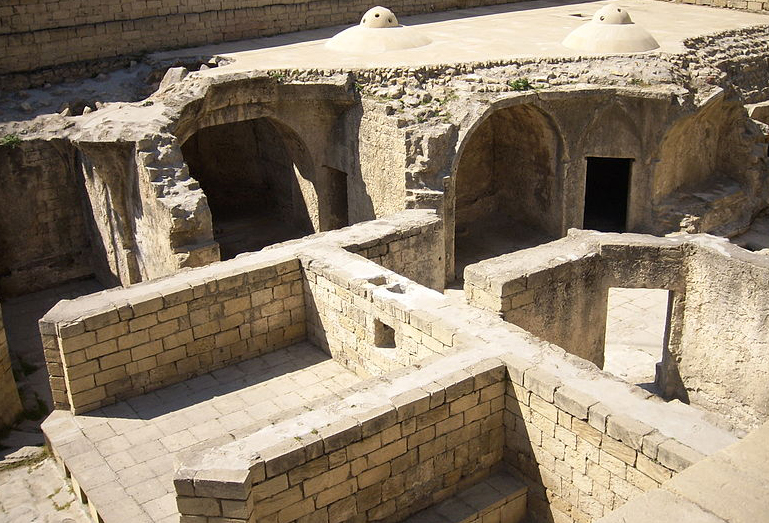 keep the regular temperature condition. The thickness of the ground layer gradually increased and has completely covered it. The hamam was revealed in 1939 accidentally, one its part was cleaned in 1953, it was conserved in 1961. According to the walls survived till our days, it can be stated that its rooms were domed. The hamam was lightened through the slots in the dome. Such hamam systems are typical for Baku and Absheron. The left part of the hamam has been rehabilitated, the right part has better held its shape.
keep the regular temperature condition. The thickness of the ground layer gradually increased and has completely covered it. The hamam was revealed in 1939 accidentally, one its part was cleaned in 1953, it was conserved in 1961. According to the walls survived till our days, it can be stated that its rooms were domed. The hamam was lightened through the slots in the dome. Such hamam systems are typical for Baku and Absheron. The left part of the hamam has been rehabilitated, the right part has better held its shape.
Water to hamam flowed from an ovdan (ancient underground water supply construction) near the wall to a boiler room, then was distributed to rooms through special built ways. There were also so called “secret” rooms for undressing or individual bathing. The end of the pipe laid in walls to the rooms is seen in the arch.
In the right corner of the hamam there are one large and two small domed rooms. Probably, these rooms covered with glazed tiles belonged personally to the shah.
 Ovdan. Ovdan is built in the form of a portal, many stairs lead to the storage from there. Connection existed between the ovdan and hamam is seen from a vestibule. Water to ovdan was supplied through kehriz (underground pipes) from a fine example of monumental and decorative arts of medieval Azerbaijan.
Ovdan. Ovdan is built in the form of a portal, many stairs lead to the storage from there. Connection existed between the ovdan and hamam is seen from a vestibule. Water to ovdan was supplied through kehriz (underground pipes) from a fine example of monumental and decorative arts of medieval Azerbaijan.
Mohammad Mosque
Referring to an epigraphic inscription (Arabian Cufic writing) on the entrance door, the mosque was built in 471 Anno Hegira (1078-1079 AD) by master Mohammmad Abubekir oglu. A small vestibule adjoins on the north of the one-room praying hall embellished with rich decorative elements. Along the centre line of the fortress wall is a pair of windows covered with tracery. The hall covered with a pointed ceiling on the eastern and western parts was embellished with the windows with crumbling ornament. It is interesting that a band-shape ornament along the frame of the arcade was built with burnt brick which is alien to the Baku-Absheron architecture.
In the folk etymology, the monument is also named “Siniggala”. The magnificent monument suffered during artillery bombardment from the sea ordered by the Admiral of the Russian Fleet Matyushkin sent by Peter the Great to Baku on a reconnaissance mission and the top of the minaret of its mosque was broken away, that is why it is known as “Siniggala”. The  cylindrical minaret attached to the mosque ends on the top with a tracery muezzin balcony set on a stalactite cornice. Spiral stone staircases built within the minaret start from the floor of the prayer hall. At some height, the minaret has a door leading to the mosque roof. Large stone slabs are laid on the roof. A Quran aya is inscribed in Arabic with Cufic writing along the stalactite belt on the upper part of the minaret. The base of the minaret is low and square. The southern façade of the mosque has oblong proportions expressed in a protruding semicylindrical mehrab and pointed windows on the background of the millennial stone wall. Dynamics of spatial composition of the mosque is expressed in the minaret which overshadows the adjacent buildings. The rehabilitation works have completely restored an architectural image of the ancient mosque which has an epigraphic inscription.
cylindrical minaret attached to the mosque ends on the top with a tracery muezzin balcony set on a stalactite cornice. Spiral stone staircases built within the minaret start from the floor of the prayer hall. At some height, the minaret has a door leading to the mosque roof. Large stone slabs are laid on the roof. A Quran aya is inscribed in Arabic with Cufic writing along the stalactite belt on the upper part of the minaret. The base of the minaret is low and square. The southern façade of the mosque has oblong proportions expressed in a protruding semicylindrical mehrab and pointed windows on the background of the millennial stone wall. Dynamics of spatial composition of the mosque is expressed in the minaret which overshadows the adjacent buildings. The rehabilitation works have completely restored an architectural image of the ancient mosque which has an epigraphic inscription.
During archaeological excavations in 1988, archaeologist F. A. Ibrahimov discovered an unexpected large-scale pattern of the mosque. The minaret which always was recognised in its low shape now has appeared as a perfect structure built on the square base. A similar type room covered with a pointed dome was revealed below the prayer hall. Beneath a lower layer of the room elements of pre-Islamic religious ceremonies have been traced. Artefacts found during the archaeological excavations give ground to believe that the room was built just in the antique period. It is supposed that the mosque was erected over the foundation of a pre-Islamic temple of fire existed here. Columns with capital revealed in the room are a strong evidence proving that Baku is a city of great antiquity.
Monuments of National Value
Seyid Yayha Murtuza Mosque
The mosque located on a medieval caravan road was built at the beginning of the XVII century. It is square in plan and centrally –domed. On the southern wall is a stalactite-tier 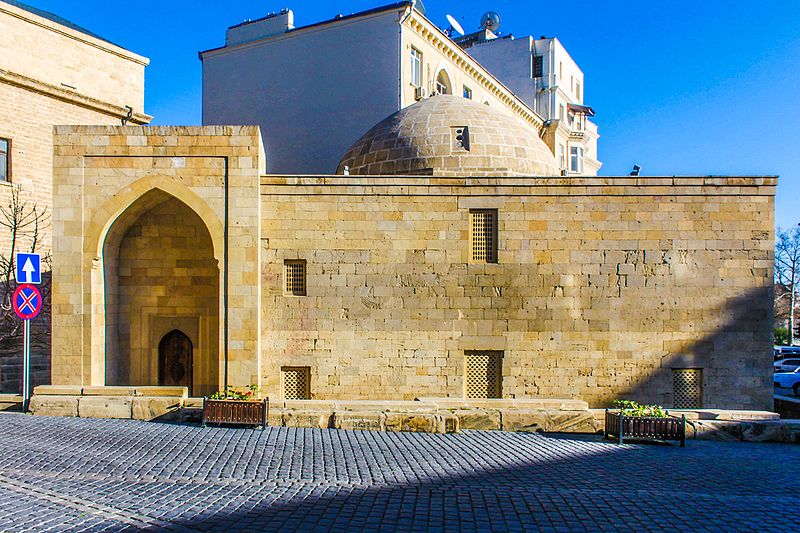 mehrab (mihrab). A distinguished personality of that time Seyid Yahya Murtuza ordered the construction of the mosque. Being a clergyman, he served as the akhund of the mosque. Under his will, he was buried in the mosque courtyard. Now his tomb is near the mosque entrance.
mehrab (mihrab). A distinguished personality of that time Seyid Yahya Murtuza ordered the construction of the mosque. Being a clergyman, he served as the akhund of the mosque. Under his will, he was buried in the mosque courtyard. Now his tomb is near the mosque entrance.
Sheykh Ibrahim Mosque
 The Mosque is located on the main commercial road which changes its direction towards the Salyan Gate. An epigraphic inscription on façade indicates the name of the customer, Haji Amirshah Yaqub oglu. Another inscription says that the Mosque was restored by Agha Gafar Haji Muradoglu. The main inscription indicates that the Mosque was built in hegira 818 (1415 -1416) in times of Sultan Sheyh Ibrahim. Therefore, people gave it the name of Sheyh Ibrahim. The Mosque is four-cornered and is covered with a pointed stone cupola. While a mehrab is to be at a traditional sidewall, it is placed on a lengthwise wall. In the XIX century the surface of mosque façade wall was divided into three quadrangle frames and thus the façade had got the European architectural style. In each frame a window ending with aperture /slot was placed, the entrance was made in the form of a portal. Preserving the ancient content of national architectural monuments, local and European motifs are combined on the single architectural platform.
The Mosque is located on the main commercial road which changes its direction towards the Salyan Gate. An epigraphic inscription on façade indicates the name of the customer, Haji Amirshah Yaqub oglu. Another inscription says that the Mosque was restored by Agha Gafar Haji Muradoglu. The main inscription indicates that the Mosque was built in hegira 818 (1415 -1416) in times of Sultan Sheyh Ibrahim. Therefore, people gave it the name of Sheyh Ibrahim. The Mosque is four-cornered and is covered with a pointed stone cupola. While a mehrab is to be at a traditional sidewall, it is placed on a lengthwise wall. In the XIX century the surface of mosque façade wall was divided into three quadrangle frames and thus the façade had got the European architectural style. In each frame a window ending with aperture /slot was placed, the entrance was made in the form of a portal. Preserving the ancient content of national architectural monuments, local and European motifs are combined on the single architectural platform.
Khanlar Mosque
The Mosque was built in the late 19th century to order of the Khanlarov brothers near their house according to the architect Mashadi Mirza Gafar Izmaylov’s design. The small mosque 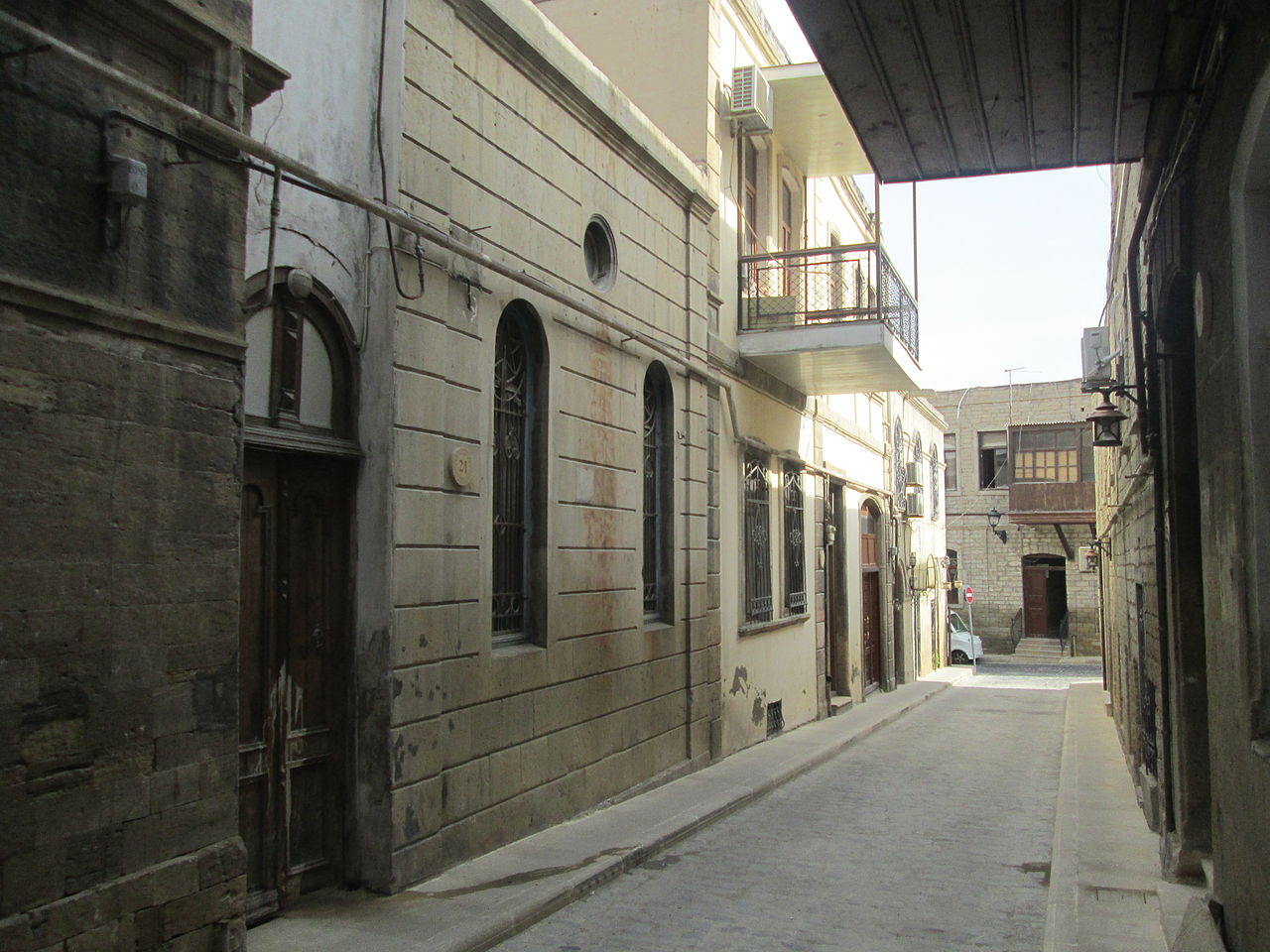 is in the form of an oblong square located in a row of neighbourhoods (mahalla). The entrance is divided into three sections. The central one ends with a radial dome, the others are covered by a cupola. Along a centre line of the hall, a mehrab is placed exhibiting an interesting plastic architectural composition with safety windows on the winds and rich decoration. The interior is rich in floral decoration motifs. This adds sublimity and luxury to the interior. The mosque is one of the latest religious monuments built within the Icherisheher.
is in the form of an oblong square located in a row of neighbourhoods (mahalla). The entrance is divided into three sections. The central one ends with a radial dome, the others are covered by a cupola. Along a centre line of the hall, a mehrab is placed exhibiting an interesting plastic architectural composition with safety windows on the winds and rich decoration. The interior is rich in floral decoration motifs. This adds sublimity and luxury to the interior. The mosque is one of the latest religious monuments built within the Icherisheher.
Haji Bani Mosque
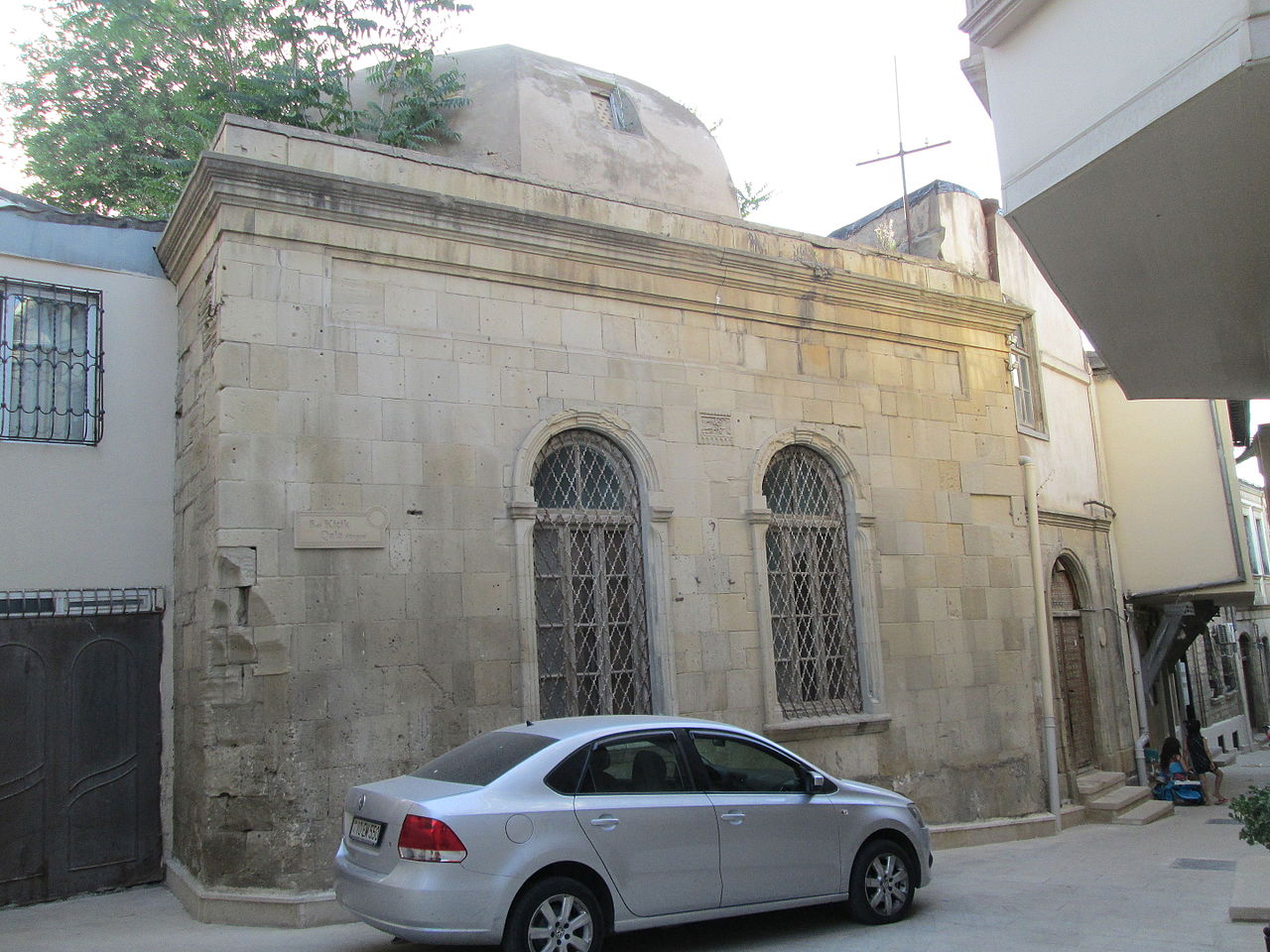 The Mosque is located near the Shirvanshahs Palace Complex. According to a short epigraphic inscription on the façade, it was built by architect Haji Bani. It is centrally-domed in the plan. Opposite to the entrance is a megalithic masonry, stalactite tier mehrab. Another epigraphic inscription says that the mosque was rehabilitated in 1320 Anno Hegira (1902 -1903). At that time reconstruction was undertaken, a vestibule and a special part intended for women (Shabiistan) were added. Double semi-circular windows provided double lighting for a prayer hall. During reconstruction of the mosque, its interior and exterior have preserved their traditional styles and motives. Expressive silhouette, construction on cubic foundation, representation of the Absheron-type spherical cone-shaped dome stone, nicely accentuating a downward corner of the street express specific features of local architecture.
The Mosque is located near the Shirvanshahs Palace Complex. According to a short epigraphic inscription on the façade, it was built by architect Haji Bani. It is centrally-domed in the plan. Opposite to the entrance is a megalithic masonry, stalactite tier mehrab. Another epigraphic inscription says that the mosque was rehabilitated in 1320 Anno Hegira (1902 -1903). At that time reconstruction was undertaken, a vestibule and a special part intended for women (Shabiistan) were added. Double semi-circular windows provided double lighting for a prayer hall. During reconstruction of the mosque, its interior and exterior have preserved their traditional styles and motives. Expressive silhouette, construction on cubic foundation, representation of the Absheron-type spherical cone-shaped dome stone, nicely accentuating a downward corner of the street express specific features of local architecture.
Molla Ahmad Mosque
The Mosque is attributed to the types of Icherisheher community (mahalla) mosques. It was ordered by Nasraddin Gushatsi bin Hasan Hajibaba, and was built at the beginning of the  XIV century by master architect Mahmud ibn Sad, the author of known Absheron buildings as well as a castle in the Nardaran village (1301) and a mosque with a minaret in the Bibi-Heybat village (late XX). It is known as Molla Ahmad Mosque for the name of its akhund (theologian) Molla Ahmad. The Mosque is square in plan and consists of a small hall. A simple mehrab on the southern wall, a low stone crowned cupola on the sides are in a good match. A rather modest asymmetric façade is complemented with a thoroughly shaped entrance and two small windows which were added later. On the upper part of the façade, an inscription presented in the form of an extended strip gives comprehensive information in two lines in Arabic writing on the construction of the building including its customer and an architect who was actively involved in the construction of military, religious memorial monuments. In his works the development of stylistic devices representing the Shirvanshahs’ period which is a part of the architectural heritage is traceable.
XIV century by master architect Mahmud ibn Sad, the author of known Absheron buildings as well as a castle in the Nardaran village (1301) and a mosque with a minaret in the Bibi-Heybat village (late XX). It is known as Molla Ahmad Mosque for the name of its akhund (theologian) Molla Ahmad. The Mosque is square in plan and consists of a small hall. A simple mehrab on the southern wall, a low stone crowned cupola on the sides are in a good match. A rather modest asymmetric façade is complemented with a thoroughly shaped entrance and two small windows which were added later. On the upper part of the façade, an inscription presented in the form of an extended strip gives comprehensive information in two lines in Arabic writing on the construction of the building including its customer and an architect who was actively involved in the construction of military, religious memorial monuments. In his works the development of stylistic devices representing the Shirvanshahs’ period which is a part of the architectural heritage is traceable.
Small Caravanserai
 A caravanserai known as a small or “Khan caravanserai” was built in late XV –early XVI. It is square in plan. It has a large quadrangle with truncated corners. It has a perimeter balcony. Behind the balcony are private premises. Along the north-south axis, there is a one-room through entrance connecting commercial streets. The decorative architecture of the courtyard is built on traditional forms – pointed arch balconies within flat quadrangle frame. A simple –form cornice connects hall facades of the building along its perimeter. The Northern and southern entrances of the caravanserai are in the form of portal. In the Middle Ages, the main entrance portal of the caravanserai was from the sea-side. The southern façade of the caravanserai was two-storey and exhibits a magnificent fortification. In medieval times the commercial street side of the caravanserai consisted of shops which had no direct communication with the courtyard. It is believed that before functioning as a caravanserai the building comprised Jame Mosque and its medrese and the cells existed in its courtyard. The caravanserai is located in the main commercial street of the city and takes key place in the urban system.
A caravanserai known as a small or “Khan caravanserai” was built in late XV –early XVI. It is square in plan. It has a large quadrangle with truncated corners. It has a perimeter balcony. Behind the balcony are private premises. Along the north-south axis, there is a one-room through entrance connecting commercial streets. The decorative architecture of the courtyard is built on traditional forms – pointed arch balconies within flat quadrangle frame. A simple –form cornice connects hall facades of the building along its perimeter. The Northern and southern entrances of the caravanserai are in the form of portal. In the Middle Ages, the main entrance portal of the caravanserai was from the sea-side. The southern façade of the caravanserai was two-storey and exhibits a magnificent fortification. In medieval times the commercial street side of the caravanserai consisted of shops which had no direct communication with the courtyard. It is believed that before functioning as a caravanserai the building comprised Jame Mosque and its medrese and the cells existed in its courtyard. The caravanserai is located in the main commercial street of the city and takes key place in the urban system.
Agha Mikayil Hamam
The Hamam (bath-house) was built in the XVIII by Haji Agha Mikayil from Shamakhi, on the south-west of the Icherisheher in one of the main streets, Kichik Gala street. The area 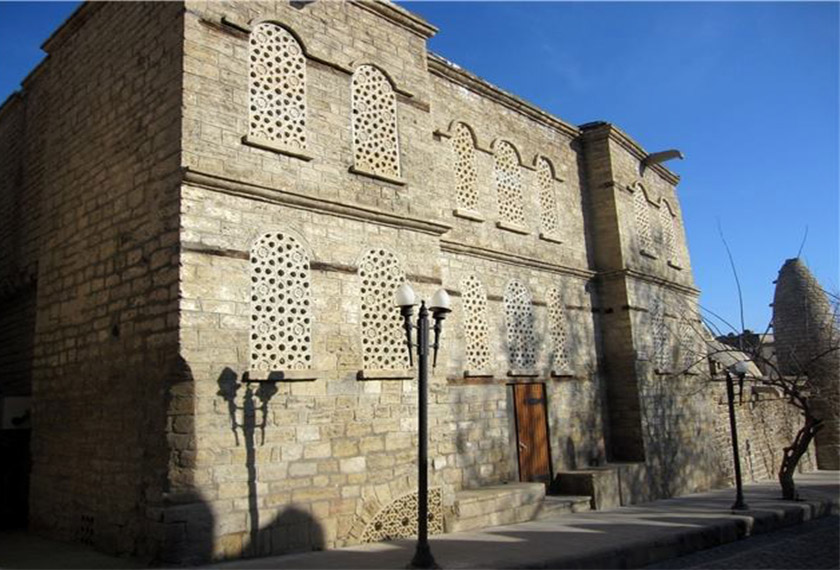 where it is located is known in folk etymology a “bath keepers” community (hamamchilar mahalasi). The hamam is entered from Kichik Gala street. The interior of the building is distinct among other hamams for its large space (spaciousness). Cloakroom and bath-rooms are square-shaped. Due to the four central pillars, the premises form a large composition. Architectural composition of the hamam is expressed with pointed arches, cupolas, domes divided by proportional tiers. Attractive volumes of domes dominating over strong façade and stone made following the vernacular architectural traditions have formed the basis of the hamam. A chimneystack of peculiar form is boldly silhouetted above the building. The monument is incorporated into the southern-east town civil system.
where it is located is known in folk etymology a “bath keepers” community (hamamchilar mahalasi). The hamam is entered from Kichik Gala street. The interior of the building is distinct among other hamams for its large space (spaciousness). Cloakroom and bath-rooms are square-shaped. Due to the four central pillars, the premises form a large composition. Architectural composition of the hamam is expressed with pointed arches, cupolas, domes divided by proportional tiers. Attractive volumes of domes dominating over strong façade and stone made following the vernacular architectural traditions have formed the basis of the hamam. A chimneystack of peculiar form is boldly silhouetted above the building. The monument is incorporated into the southern-east town civil system.
Molla Ahmad Mosque
 The Mosque is attributed to the types of Icherisheher community (mahalla) mosques. It was ordered by Nasraddidn Qushatsi bin Hasan Hajibaba, and was built at the beginning of the XIV century by master architect Mahmud ibn Sad, the author of known Absheron buildings as well as a castle in the Nardaran village (1301) and a mosque with a minaret in the Bibi-heybat village (late XX). It is known as Molla Ahmad Mosque for the name of its akhund (theologian) Molla Ahmad. The Mosque is square in plan and consists of a small hall. A simple mehrab on the southern wall, a low stone crowned cupola on the sides are in a good match. A rather modest asymmetric façade is complemented with a thoroughly shaped entrance and two small windows which were added later. On the upper part of the façade, an inscription presented in the form of an extended strip gives comprehensive information in two lines in Arabic writing on the construction of the building including its customer and an architect who was actively involved in the construction of military, religious memorial monuments. In his works the development of stylistic devices representing the Shirvanshahs' period which is a part of the architectural heritage is traceable.
The Mosque is attributed to the types of Icherisheher community (mahalla) mosques. It was ordered by Nasraddidn Qushatsi bin Hasan Hajibaba, and was built at the beginning of the XIV century by master architect Mahmud ibn Sad, the author of known Absheron buildings as well as a castle in the Nardaran village (1301) and a mosque with a minaret in the Bibi-heybat village (late XX). It is known as Molla Ahmad Mosque for the name of its akhund (theologian) Molla Ahmad. The Mosque is square in plan and consists of a small hall. A simple mehrab on the southern wall, a low stone crowned cupola on the sides are in a good match. A rather modest asymmetric façade is complemented with a thoroughly shaped entrance and two small windows which were added later. On the upper part of the façade, an inscription presented in the form of an extended strip gives comprehensive information in two lines in Arabic writing on the construction of the building including its customer and an architect who was actively involved in the construction of military, religious memorial monuments. In his works the development of stylistic devices representing the Shirvanshahs' period which is a part of the architectural heritage is traceable.
Mosque and Mosque courtyard - prayer place
For a more thorough study of the religious context around the Maiden Tower the archaeologist F. Ibrahimov carried out excavation works (1990-93) and a mosque dated back to the IX 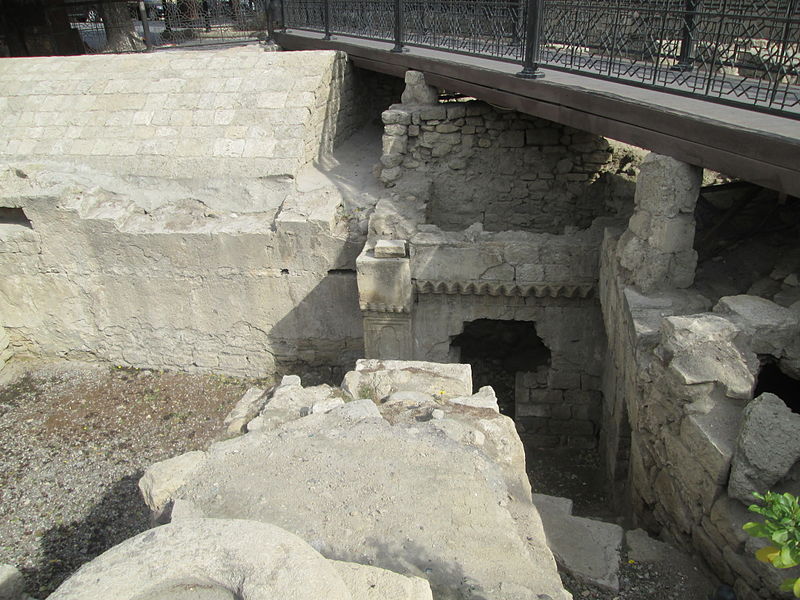 century was found to the north of the Tower. Short-term archeological excavations done in this area in 1988 revealed the existence of another 2 rooms.
century was found to the north of the Tower. Short-term archeological excavations done in this area in 1988 revealed the existence of another 2 rooms.
During the excavations continued in the floor of the larger room a mehrab (pulpit) within an arched niche was found in the western wall close to its southwestern corner. On the top of the mehrab is a two-word Arabic inscription in Cufic writing. The inscription was read by the researcher -epigrapher Mashadikhanum Nemat. The inscription says: "All Power resides with Allah". Based on the comparative analysis and handwriting specifics, the researchers attribute this inscription to VIII-IX centuries. The mosque, the adjoining premises, and the arcade give grounds for supposing that were incorporated into a single complex. Given that the city was located on a commercial- caravan rote it also a guess may be given on existence of a Khanegah (place for dervishes) in this area. The historian archaeologist F. Ibrahimov believes this mosque is the mosque of a distinguished theologian and clergyman, Bakuvian by birth (born in Baku), Baba Kuhi Bakuvi.
